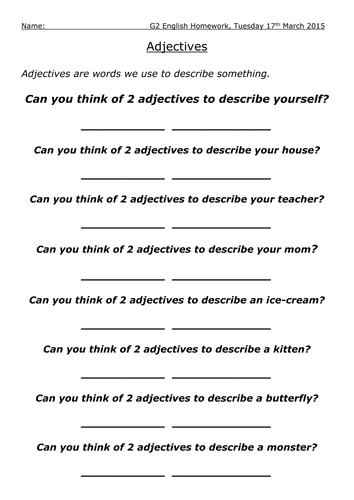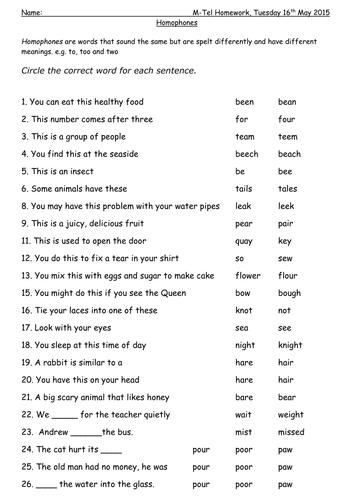384Uploads
1729k+Views
2377k+Downloads
World languages

Being Verbs (am, is, are)
Basic homework worksheet.With rule.Decide (based upon the pronoun or noun) whether the being verb should be 'am', 'is' or 'are'...fill in the blank.(1 non-commercial clip-art image of a happy panda...I am happy, yes I am!)

Was or Were ?
Was and were are the past tenses of verb "to be".23 easy to read, child friendly sentences with missing were or was.1-\tIdentify the subject of the sentence.2-\tIdentify whether it is a singular or plural noun. 3-\tFill in the blank in the sentences using ‘was’ or ‘were’ 4-\tThen on the line at the end write whether the noun was singular or plural.

Adjective Worksheet Pack
10 adjectives worksheets; Range of levels from gaining initial knowledge to applying it in sentence writing.Designed for a mixed year 1 & 2 Cambodian international school, students of very mixed abilities. (some differentiated HA/MA/LA worksheets also provided) +cut and stick into adjective groups activity (words on A4/table is A3)Hope that people find them useful. Please rate and comment if you do!

Word Order Effecting Meaning
Sentences need to make sense. The order of the words in a sentence can change the meaning of the sentence. Students read the two sentences and choose the one that makes the most sense.e.g.Ben ate a hotdog.A hotdog ate Ben.EAL or ESL homework activity.

Homophones Choice
Homophones are words that sound the same but are spelt differently and have different meanings. e.g. to, too and twoStudents have to circle the correct word (homophone) for each sentence.Homework worksheet.

Synonyms and Antonyms Basic
2 basic introductory worksheets for KS1 & ESL student homework. 1: They need to read carefully whether the written answer should be either a synonyms or an antonym.2: Synonym Sort. with synonyms for good, bad, hot, silent, big, small.Easy to differentiate - just change the words.

Verbs, Nouns & Adjectives
Lots of words and a few sentences. Students are asked to...Circle the noun, cross out the adjective and draw a zigzag star around the verb.EAL/ESL Homework for grade/year 1 or 2.

Grammar - Subject of Sentence
3 different activities (over 4 pages) to help students identify and think about the subject of a sentence. \n1. Underline the complete subject in the sentence.\n2. Add an appropriate subject to the sentence.\n3. Read the sentence, identify the subject, match to (non-commercial) clip-art.\n

Rhyming Words Sorting (Tricky Words)
Tricky rhyming words sorting/matching activity. Includes various different spelling patterns making same vowel sound.

o_e split digraph
o_e split digraph
o_e split digraph worksheets (30 words, 30 clip-art, words on separate page)
o_e split digraph flashcards (2 version with 40 words and illustrations)
o_e split matching game (40 words, match word to image memory game)

Adverbs of Frequency Mats Worksheets
Adverbs of frequency word mats and adverb of frequency worksheets.
Also adverb of frequency poster.

Lion and Mouse Fable
Differentiated reading comprehension fable retellings of Aesop’s ‘The Lion and the Mouse’
These differentiated retellings of Aesop’s “The Lion and the Mouse” offers three levels of complexity (higher, middle, and lower), students of all abilities can engage with the text and develop their skills. The higher level includes more advanced vocabulary and ten in-depth comprehension questions, while the middle level offers simpler synonyms and nine questions. The lower level is the easiest to read, with a shorter text and seven questions. All levels come with a handy answer key.

Jack and the Beanstalk
Differentiated reading comprehension worksheets for the classic fairytale ‘Jack and the Beanstalk’.
This carefully retold story is written at three levels appropriate for readers aged from 6 to 11 years old.
The higher level text is double sided, has a larger word count and features more ambitious vocabulary and includes 16 questions, including vocabulary questions.
The middle level is double sided, has fewer and easier to comprehend words and comes with two question sheet versions; one with 14 questions, another with 10 questions.
The lower level text has been simplified for lower-level readers, but follows the structure of the other two higher texts and is therefore also double sided but uses mainly decodable and high frequency words and has 9 comprehension question using easy to read and answer questions.
All levels come with answer sheets.
Looking for other classic fairy tale reading worksheets?
Little Red Riding Hood
Hansel and Gretel
Snow White and the Seven Dwarfs
Rapunzel
And many more reading printables in my shop!

Hansel and Gretel Reading Comprehension
7 way differentiated reading comprehension worksheets for the fairytale ‘Hansel and Gretel,’ at three reading levels suitable for readers aged 6-12 years old.
The higher-level text is double-sided, features a larger word count, more complex vocabulary, and includes two versions of questions: a 21-question higher-level comprehension version and a 14-question version.
The middle-level text is double-sided, includes simpler vocabulary, and has three sets of comprehension question sheets: 15, 11, and 8-question versions.
The lower level text have been simplified for lower-level readers, but still follow the structure of the higher-level texts. It is a slightly shortened version that mainly uses decodable and high-frequency words. There are two sets of questions for the lower-level version: a 10-question version and a ‘circle yes or no’ version, perfect for EAL learners.
All levels come with answer sheets.
More reading comprehension fairy tales:
Rapunzel
Emperor’s New Clothes
Elves and the Shoemaker
Aladdin

Fairytale Old Woman in Forest
8-way differentiated reading comprehension, suitable for readers aged 6 to 11 years, for the classic fairy tale ‘The Old Woman in the Forest’ in which a young girl who gets lost in the woods is assisted by a little white bird who helps her find a ring in an old lady’s house, leading her to meet a handsome prince in the forest and ultimately find true love.
The higher-level text uses more complex vocabulary, some extra literary devices and a larger word count. It includes two versions of comprehension questions:
➊ A 16 question classic answer sheet where students write answers on the lines. It is double sided.
➋ A 16 question multiple choice version with 3 answer choices.
The middle-level text has a slightly smaller word count and simpler vocabulary. It comes with two sets of comprehension questions:
➌ A classic 17 question worksheet.
➍ A 12 question worksheet.
➎ A 14 question multiple choice version with 3 answer choices.
The lower-level text has been simplified for easier reading, using mainly decodable and high-frequency words whenever possible, apart from a few essential story words. This version includes three sets of questions:
➏ A 10 question classic worksheet
➐ A 6 question classic worksheet
➑ A 14 question ‘circle yes or no’ worksheet perfect for beginner EAL learners.
All levels of worksheets come with answer sheets.

Noun Mats Noun Worksheets
Noun mats (noun scaffolds) and matching noun worksheets.
Differentiated versions uploaded.
Blank version also uploaded for children to make their own examples.

Possessive Nouns
Mastering Possessive Nouns: Comprehensive Resource
This comprehensive kit provides educators with a variety of tools to teach possessive nouns effectively:
Instructional Materials:
15 colorful posters/anchor charts illustrating:
• Singular possessive nouns
• Plural possessive nouns (ending in ‘s’ and not ending in ‘s’)
• Possessive apostrophe usage rules
Practice Resources:
6 differentiated worksheets:
• 1 illustrated worksheet for visual learners
• 5 text-based worksheets of varying difficulty levels
Interactive Learning:
1 blank matching poster template for students to create their own examples
Key Concepts Covered:
Distinguishing between plural and possessive nouns
Singular noun possessive rules
Plural noun possessive rules (for nouns ending in ‘s’ and those that don’t)
Correct placement of possessive apostrophes
This resource is designed to cater to diverse learning styles and provide ample opportunities for practice and reinforcement of possessive noun concepts.

Adverb Mats Adverb Posters
Adverb mats & adverb posters.
Differentiated adverb scaffolds. Some with more adverbs, some with less adverbs. Plus adverbs of manner place mat.
Adverb mats are A4. Adverb posters are A3.

Charles Dickens Biography
Charles Dickens biography reading comprehension.
Charles Dickens novel summary comprehension.
Differentiated three ways. Lots of Charles Dickens facts.
The biographies have glossaries to help at each level.
Differentiated questions with answer sheets provided.
Suitable for KS2 & KS3.




















